-
 Bitcoin
Bitcoin $115200
-2.68% -
 Ethereum
Ethereum $3601
-5.16% -
 XRP
XRP $3.035
-2.96% -
 Tether USDt
Tether USDt $0.9997
-0.04% -
 BNB
BNB $764.5
-5.43% -
 Solana
Solana $168.1
-5.92% -
 USDC
USDC $0.9998
-0.02% -
 Dogecoin
Dogecoin $0.2090
-4.80% -
 TRON
TRON $0.3272
-0.49% -
 Cardano
Cardano $0.7306
-5.00% -
 Hyperliquid
Hyperliquid $39.16
-12.22% -
 Stellar
Stellar $0.3967
-4.96% -
 Sui
Sui $3.566
-5.95% -
 Chainlink
Chainlink $16.55
-6.57% -
 Bitcoin Cash
Bitcoin Cash $552.3
-3.90% -
 Hedera
Hedera $0.2516
-4.69% -
 Avalanche
Avalanche $21.99
-5.75% -
 Toncoin
Toncoin $3.621
-0.28% -
 Ethena USDe
Ethena USDe $1.000
-0.03% -
 UNUS SED LEO
UNUS SED LEO $8.951
0.02% -
 Litecoin
Litecoin $105.9
-3.59% -
 Shiba Inu
Shiba Inu $0.00001232
-5.00% -
 Polkadot
Polkadot $3.640
-5.55% -
 Uniswap
Uniswap $9.048
-7.03% -
 Monero
Monero $301.8
-1.51% -
 Dai
Dai $0.9999
-0.01% -
 Bitget Token
Bitget Token $4.334
-3.66% -
 Pepe
Pepe $0.00001064
-6.17% -
 Cronos
Cronos $0.1367
-5.78% -
 Aave
Aave $259.2
-4.59%
How long does it take for LTC mining to pay back? How to estimate the payback period?
To estimate LTC mining payback, calculate daily revenue from Litecoins mined and subtract costs like hardware and electricity, then divide initial investment by net daily profit.
May 02, 2025 at 01:56 am
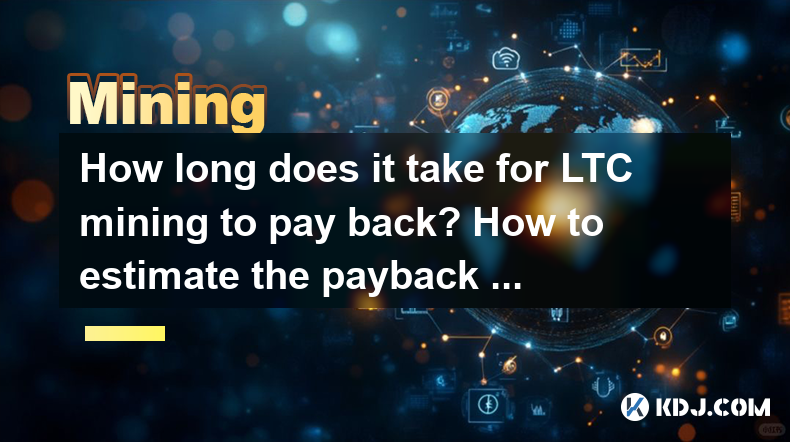
How long does it take for LTC mining to pay back? How to estimate the payback period?
Litecoin (LTC) mining can be a profitable venture, but understanding the payback period is crucial for miners to make informed decisions. The payback period for LTC mining varies based on several factors, including hardware costs, electricity rates, mining difficulty, and Litecoin's market price. In this article, we will delve into the details of how to estimate the payback period for LTC mining and what elements you should consider.
Understanding the Basics of LTC Mining
Before diving into the payback period, it's important to understand the basics of Litecoin mining. Litecoin uses the Scrypt algorithm, which is different from Bitcoin's SHA-256. This algorithm is more memory-intensive, making it less susceptible to ASIC dominance in the early days, though ASICs for Scrypt now exist. Miners use specialized hardware to solve complex mathematical problems, and in return, they are rewarded with Litecoins.
Factors Affecting the Payback Period
Several factors influence the payback period for LTC mining:
- Hardware Costs: The initial investment in mining hardware is a significant factor. The cost of ASIC miners varies widely, from a few hundred to several thousand dollars.
- Electricity Rates: Mining consumes a lot of electricity. The cost per kilowatt-hour (kWh) in your area will significantly impact your operational costs.
- Mining Difficulty: As more miners join the network, the difficulty of mining increases, which can reduce the number of Litecoins you mine per day.
- Litecoin Price: The market price of Litecoin directly affects the revenue from mining. A higher price means more revenue per Litecoin mined.
Calculating the Payback Period
To estimate the payback period, you need to calculate both your daily revenue and daily costs. Here’s how to do it step-by-step:
Calculate Daily Revenue:
- First, determine your mining hardware's hash rate. For example, if your miner has a hash rate of 1 TH/s (terahash per second).
- Use a mining calculator to estimate how many Litecoins you can mine per day. Mining calculators consider the current network difficulty and block reward.
- Multiply the number of Litecoins mined per day by the current price of Litecoin to get your daily revenue in your local currency.
Calculate Daily Costs:
- Determine the power consumption of your mining hardware in watts. For example, if your miner consumes 1500 watts.
- Convert the power consumption to kilowatts (1500 watts = 1.5 kW).
- Multiply the power consumption in kW by the number of hours in a day (24 hours) and then by your electricity rate per kWh. For example, if your electricity rate is $0.10 per kWh, your daily electricity cost would be 1.5 kW 24 hours $0.10/kWh = $3.60.
Calculate Net Daily Profit:
- Subtract your daily costs from your daily revenue to find your net daily profit.
Calculate Payback Period:
- Divide your initial hardware cost by your net daily profit to find the number of days it will take to break even.
Example Calculation
Let’s walk through an example to illustrate this process:
Hardware Cost: $1,000
Hash Rate: 1 TH/s
Power Consumption: 1500 watts (1.5 kW)
Electricity Rate: $0.10 per kWh
Litecoin Price: $100
Litecoins Mined per Day: 0.05 LTC (hypothetical value from a mining calculator)
Daily Revenue: 0.05 LTC * $100/LTC = $5
Daily Costs: 1.5 kW 24 hours $0.10/kWh = $3.60
Net Daily Profit: $5 - $3.60 = $1.40
Payback Period: $1,000 / $1.40 = approximately 714 days
Tools and Resources for Estimation
Several online tools and resources can help you estimate the payback period for LTC mining:
- Mining Calculators: Websites like WhatToMine and Coinwarz offer detailed mining calculators that consider current network difficulty, block rewards, and electricity costs.
- Hardware Specifications: Manufacturer websites provide detailed specifications on hash rates and power consumption for their mining hardware.
- Electricity Rate Databases: Websites like Electricity Local can help you find the average electricity rate in your area.
Adjusting for Variables
The variables used in the calculation can change over time, affecting your payback period. Here are some adjustments you might need to make:
- Monitoring Litecoin Price: The price of Litecoin can be volatile. Regularly updating your calculations with the current price is essential.
- Adjusting for Mining Difficulty: As the network difficulty changes, the number of Litecoins you can mine per day will also change. Use mining calculators that allow you to input current difficulty levels.
- Considering Hardware Upgrades: As newer, more efficient mining hardware becomes available, upgrading can reduce your payback period.
Frequently Asked Questions
Q: Can I mine Litecoin with a GPU?
A: While it is technically possible to mine Litecoin with a GPU, it is not economically viable due to the dominance of ASIC miners. GPUs are less efficient and will have a much longer payback period, if any.
Q: How does pool mining affect the payback period?
A: Mining in a pool can provide more consistent revenue, as you receive smaller, more frequent payouts rather than waiting for a larger, less frequent block reward. This consistency can help with more accurate payback period calculations, but pool fees should be factored into your costs.
Q: Is it worth starting LTC mining now?
A: The profitability of starting LTC mining depends on current market conditions, hardware costs, and electricity rates. It's essential to perform a detailed cost-benefit analysis using the latest data to determine if it's worth it for your specific situation.
Q: How can I reduce my electricity costs for mining?
A: To reduce electricity costs, consider using energy-efficient mining hardware, mining during off-peak hours if your electricity provider offers different rates, and exploring renewable energy sources like solar power to offset your consumption.
Disclaimer:info@kdj.com
The information provided is not trading advice. kdj.com does not assume any responsibility for any investments made based on the information provided in this article. Cryptocurrencies are highly volatile and it is highly recommended that you invest with caution after thorough research!
If you believe that the content used on this website infringes your copyright, please contact us immediately (info@kdj.com) and we will delete it promptly.
- Cardano Price, Pi Network, and Crypto Presales: What's the Buzz?
- 2025-08-02 08:50:12
- XRP Fund Success: Teucrium CEO Reveals Trillions on the Horizon
- 2025-08-02 09:10:12
- Challenge Coins: More Than Just Collectibles – A Military Tradition
- 2025-08-02 08:30:12
- Under the Radar: Hunting for 100x Crypto Gems in a Pi Network World
- 2025-08-02 08:30:12
- Bitcoin, Solana, and Altcoin Season: What's Hot and What's Not?
- 2025-08-02 07:10:12
- Toncoin, Rollblock, and the Token Offering Landscape: A New York Minute
- 2025-08-02 07:10:12
Related knowledge
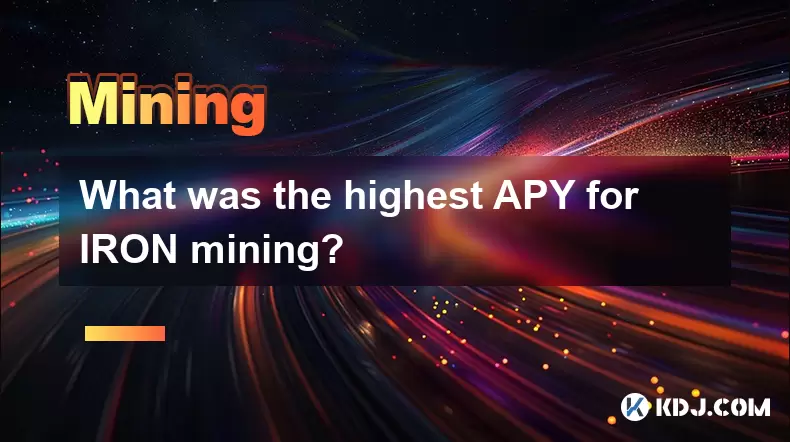
What was the highest APY for IRON mining?
Jul 23,2025 at 05:14am
Understanding IRON Token and Its Mining MechanismThe IRON token is a stablecoin that operates within the Iron Finance ecosystem, primarily on blockcha...

What is impermanent loss in IRON pools?
Jul 23,2025 at 09:00am
Understanding Impermanent Loss in the Context of IRON PoolsImpermanent loss is a phenomenon that affects liquidity providers in decentralized finance ...
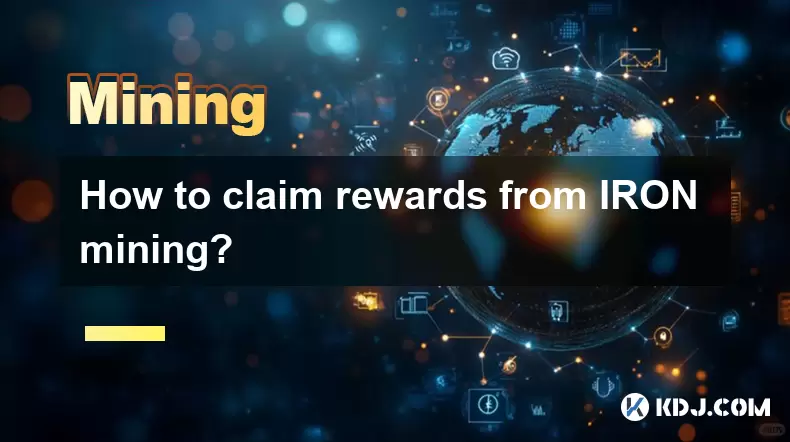
How to claim rewards from IRON mining?
Jul 23,2025 at 02:21pm
Understanding IRON Mining and Reward MechanismsIRON Finance operated as a decentralized finance (DeFi) protocol on the Polygon and Binance Smart Chain...
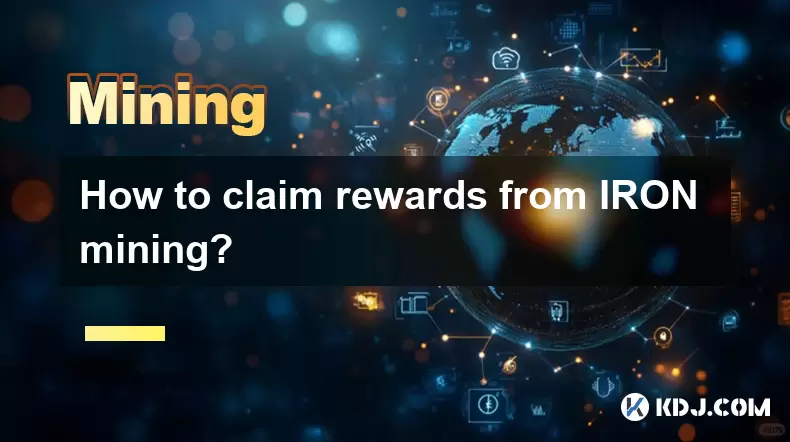
How to claim rewards from IRON mining?
Jul 29,2025 at 05:07am
Understanding IRON Mining and Reward MechanismIRON is a dual-token system designed to stabilize the value of a synthetic asset through a combination o...

IRON mining tutorial for beginners
Jul 27,2025 at 12:01am
What Is IRON and How Does It Work in the Cryptocurrency Ecosystem?IRON is a cryptocurrency token that operates on the Binance Smart Chain (BSC) and is...
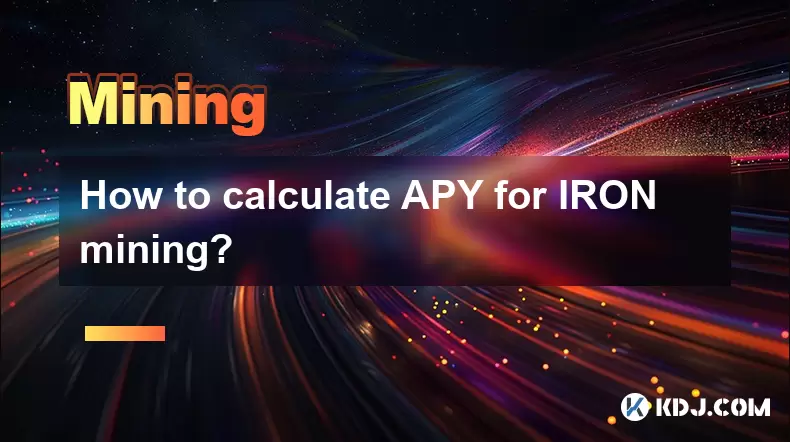
How to calculate APY for IRON mining?
Jul 28,2025 at 09:49am
Understanding APY in the Context of IRON Token MiningWhen engaging in IRON token mining within decentralized finance (DeFi) platforms, Annual Percenta...

What was the highest APY for IRON mining?
Jul 23,2025 at 05:14am
Understanding IRON Token and Its Mining MechanismThe IRON token is a stablecoin that operates within the Iron Finance ecosystem, primarily on blockcha...

What is impermanent loss in IRON pools?
Jul 23,2025 at 09:00am
Understanding Impermanent Loss in the Context of IRON PoolsImpermanent loss is a phenomenon that affects liquidity providers in decentralized finance ...

How to claim rewards from IRON mining?
Jul 23,2025 at 02:21pm
Understanding IRON Mining and Reward MechanismsIRON Finance operated as a decentralized finance (DeFi) protocol on the Polygon and Binance Smart Chain...

How to claim rewards from IRON mining?
Jul 29,2025 at 05:07am
Understanding IRON Mining and Reward MechanismIRON is a dual-token system designed to stabilize the value of a synthetic asset through a combination o...

IRON mining tutorial for beginners
Jul 27,2025 at 12:01am
What Is IRON and How Does It Work in the Cryptocurrency Ecosystem?IRON is a cryptocurrency token that operates on the Binance Smart Chain (BSC) and is...

How to calculate APY for IRON mining?
Jul 28,2025 at 09:49am
Understanding APY in the Context of IRON Token MiningWhen engaging in IRON token mining within decentralized finance (DeFi) platforms, Annual Percenta...
See all articles

























































































